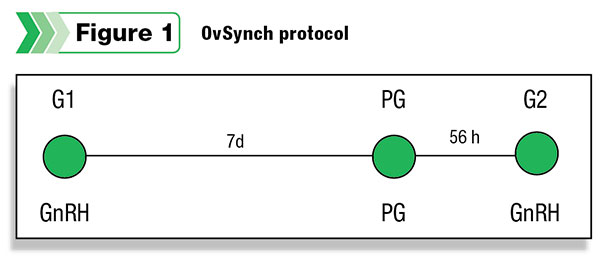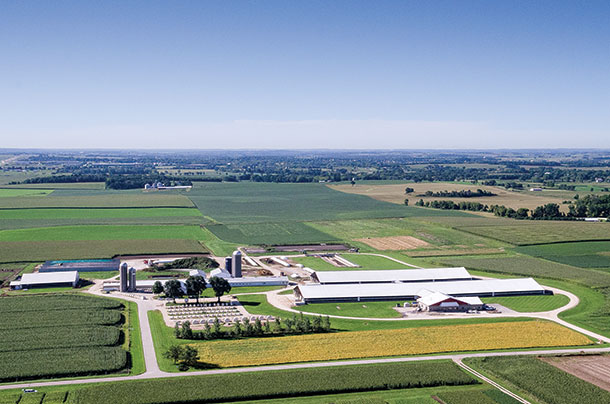It was not long ago that a 20 percent pregnancy rate (PR) was the gold standard for a productive dairy herd, but today, that bar is being raised beyond what many ever imagined.
According to the University of Wisconsin’s Dr. Paul Fricke, high-producing dairy herds are capable of capturing PRs of 30 percent or even more.
“It’s been in the last year or two that we have been able to really improve reproduction in lactating dairy cows far above what I thought we could achieve 20 years ago,” Fricke told attendees at the Professional Dairy Producers (PDPW) Dairy Reproduction Conference held in October in Oshkosh, Wisconsin.
Fricke summarized the key factors in achieving a 30 percent pregnancy rate in a herd producing 30,000 pounds of milk.
Key 1: Aggressively inseminate cows at the end of the voluntary waiting period (VWP)
When it comes to increasing pregnancies, the most basic piece of the puzzle is to get semen into cows at the end of the VWP. This simple factor drives the service rate (SR) which, combined with the conception rate (CR), yields the 21-day PR.
Over the past two decades, many dairies have moved from breeding only off of estrus to adapting a synchronization program with timed-A.I. breeding.
 While CR tends to be similar between estrus breeding and timed A.I. (around 35 percent), OvSynch protocols have proven their value by reducing the variability of when cows receive their first service and giving the dairyman more control over getting semen into them, thus improving the SR.
While CR tends to be similar between estrus breeding and timed A.I. (around 35 percent), OvSynch protocols have proven their value by reducing the variability of when cows receive their first service and giving the dairyman more control over getting semen into them, thus improving the SR.
Fricke affirmed OvSynch’s positive impact on SR but also acknowledged that the basic protocol does not address the ability of the cow to become pregnant, saying, “This is an excellent program to get semen into cows, but it will not increase fertility.”
Key 2: Increase fertility to first A.I.
There are gains to be made in fertility for cows enrolled in synchronization programs. Fricke and his colleagues have determined this can be achieved by optimizing progesterone levels at key points in the Ovsynch protocol.
“We want medium-level progesterone at G1 [first GnRH shot] and then progesterone as high as we can get it at the time of prostaglandin (PG),” he explained. At the second GnRH shot of Ovsynch [G2], the pregnancy hormone needs to be at its lowest concentration in order to maximize fertility in a healthy, ovulating cow.
However, Fricke noted that anovular cows do not have the same response to PG. Fertility is low for these cows because they are already in a low-progesterone environment.
A double Ovsynch protocol can be a useful tool in getting this group cycling and prepared for breeding because it creates two corpus luteums (CL) which boost progesterone at the time of the PG shot. This strategy is shown to get more cows pregnant while tightening up the number of cows bred by the VWP.
 The double Ovsynch protocol is particularly effective at increasing fertility among first-lactation cows. A pregnancy bump can be attained in older cows enrolled in the protocol with the addition of a second PG shot after the first one.
The double Ovsynch protocol is particularly effective at increasing fertility among first-lactation cows. A pregnancy bump can be attained in older cows enrolled in the protocol with the addition of a second PG shot after the first one.
“If there is one modification you can make to your protocols at this point in time, adding that prostaglandin is kind of a no-brainer,” Fricke stated. “It has a tremendous effect on fertility.”
He believes there is great opportunity for herds to boost conception rates with such modified protocols when they are properly implemented and carried out.
“With the new iterations of these programs, we are not only driving SR, but now also CR,” Fricke said, noting that a 50 percent CR is no longer out of reach for a well-managed, high-producing herd.
Key 3: Identify non-pregnant cows and aggressively reinseminate them
Not every cow is going to settle on the first service, so there must be a plan in place for finding open cows and rebreeding them in a timely manner. One way to do this is to watch for heats between 18 and 32 days after insemination and rebreed. Dairymen can choose from other options to identify open cows including ultrasound, palpation, milk and blood tests. Following the “open” diagnosis with a Resynch protocol sets up the group of cows to receive semen again.
Key 4: Increase fertility to second and greater A.I. services
Herds with good reproduction are not only successful at getting cows pregnant on the first service; they have also figured out how to maintain high conception rates at the second, third and even fourth breedings.
“We have a way to get fertility high on Resynch breedings,” Fricke stated. In many cases, poor fertility upon repeat breedings is linked to a lack of luteal regression. Here again, a second shot of PG given 24 hours following the first one within an Ovsynch protocol has been shown to increase pregnancies after a Resynch protocol.
Fricke also referenced a recent study showing a second PG shot added to a Resynch protocol for both five- or seven-day Ovsynch improved fertility among cows that did not have a CL at the time of the first GnRH injection. In this trial, the duration of the protocol (five versus seven days) did not affect conception rate. PD
Visit his website to find more on Fricke’s research and synchronization protocols.
PHOTO 1: With 550 cows, the UW’s Allenstein Dairy Teaching Herd is demonstrating that a high-producing herd can achieve excellent reproductive performance..
PHOTO 2: The University of Wisconsin’s Emmons Blaine Dairy Cattle Research Center in Arlington, Wisconsin. Photos courtesy of University of Wisconsin – Madison.

-
Peggy Coffeen
- Editor
- Progressive Dairyman
- Email Peggy Coffeen
30 percent pregnancy rate and 30,000 pounds of milk: How does the University of Wisconsin herd do it?
The Allenstein Dairy Teaching Herd at the Emmons Blaine Dairy Cattle Research Center in Arlington, Wisconsin, is proof that high milk production and solid reproduction really are attainable:
- 30,854 pounds of milk (305-day ME, 2X milking)
- 34 percent pregnancy rate
- 550-cow herd (more than three-quarters of the herd are second lactation or greater)
Here’s how they do it:
- Cows are enrolled in a double Ovsynch protocol with an additional prostaglandin to set them up for their first service between 76 and 82 days in milk.
- All cows receive GnRH 25 days after timed-A.I. breeding.
- At day 32, cows are pregnancy checked using ultrasound.
- Cows checked “open” with a CL continue on an Ovsynch-56 protocol, receiving one PG shot 32 days after breeding with a second PG 24 hours later.
- Cows without a CL restart Ovsynch-56 with a second PG and a CIDR.
The results speak for themselves:
- 21-day service risk: 68 percent
- Overall conception risk: 52 percent
- Conception risk to first timed A.I.: 56 percent
- Second breeding: 50 percent
- Third breeding: 45 percent
- 88 percent of cows pregnant after three services






